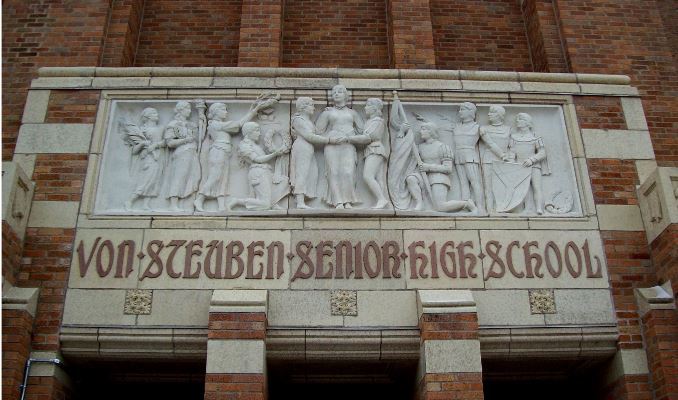Our haus
Built in 1927, we treasure the historical structure that provides a home to the DANK Haus German American Cultural Center.
The 6-floor building was designed by architect Paul Gerhardt, son-in-law of the Chicago Alderman. He also was the architect of Cook County Hospital, Lane Technical High School, Von Steuben High School, and the L&H Company Building. Originally built for the Three Links Association, a jolly fellows club. In 1967, our "Haus" located at 4740 N. Western Avenue became a home for German Chicago.

Paul Gerhardt, Sr. (1863 - 1951), the architect of the DANK Haus, was born in the town of Dobeln in what was then the Kingdom of Saxony (now part of Germany). He attended the Royal Academy in Leipzig and earned an engineering degree at the Technical University of Hanover in 1884. He then came to the United States in 1890 at the behest of the German Textile Corporation to design and construct spinning mills. He designed one of the largest mills in the United States at the time - the Botany Worsted Mill in Passaic, New Jersey. Gerhardt continued to take commissions for other large manufacturing facilities throughout his career, including a number of mill complexes, a plant for the International Gas Engine Company in LaPorte, Indiana, and a distillery in Elgin, Illinois.
Gerhardt came to Chicago in 1893 and soon started his own architectural firm, taking on various residential, commercial, and industrial projects. Prolific in the first decade of the twentieth century, his list of projects listed in the American Contractor, a trade publication, alone numbers nearly 70 between 1898 and 1910. Projects announced in the Chicago Daily Tribune from that period include apartment and flat buildings such as the brownstone-clad “Roseberry Flats” on N. Elaine St (1896). Additionally, Gerhardt’s 1910 listing in Who’s Who in Chicago cites him as the architect for “many warehouses, mercantile buildings, and hotels” in and around Chicago.

In December 1910, Gerhardt was picked to replace William Holabird as Cook County architect. Soon after, the Cook County Board announced that a new county hospital building would be constructed. As county architect, Gerhardt drew up designs for the new building, a visually impressive Beaux Arts-style building that remains on Chicago’s Near West Side along W. Harrison St. Due to numerous clashes with the County Board over the hospital building and other issues, Gerhardt was forced to resign his post as County Architect in January 1913. The design of the hospital, which was completed within the year, remained Gerhardt’s, and it remains one of his best known buildings in Chicago.

Paul Gerhardt designed the Lindemann & Hoverson Company Showroom and Warehouse Building (a designated Chicago Landmark) at 2620 W. Washington Blvd. during the years between his positions as Cook County architect and architect for the Chicago Board of Education. Other known buildings Gerhardt designed in Chicago during this time period include the Three Links Temple (now the DANK Haus German cultural center) at 4740 N. Western Ave.; Schlake Dye Works Plant, 4203 W. Grand Avenue (1921); Fraternal Order of Eagles Building (c. 1921, demolished), Carpenters’ District Council Building, and the Edgewater Athletic Club (c. 1928, demolished).
Although Paul Gerhardt, Sr., is best known for his municipal and school designs, he was a pioneer in industrial architecture for his efforts to increase the glazed wall area of reinforced concrete buildings. In 1917, Gerhardt patented a new type of industrial reinforced concrete loft design, noteworthy for introducing continuous sash or window walls to industrial buildings. Patent # 1,243,281, dated October 16, 1917, called for illuminating interior spaces through continuous window “curtain walls” made possible through the placement of interior support columns in back of the window sash line. Gerhardt’s Winston Building (1917, demolished), located at 341-349 E. Ohio St., was a seven story industrial building of flat slab construction that is considered the first structure to use this construction method.

Plan your event in one of our beautiful, historic venues. DANK Haus is full of elegant architectural details. From the marble lobby to the gilt plaster frieze of the ballroom, DANK Haus is the perfect setting for your wedding or other special event. Our Chicago skyline views will impress your guests whether native Chicagoans or out-of-towners. When you book an event at DANK Haus, we provide support to the vendors you choose. Rental income supports our educational mission and cultural programming. Contact our staff for more information or make your reservation today! |

